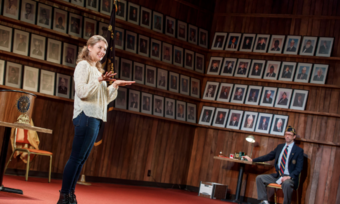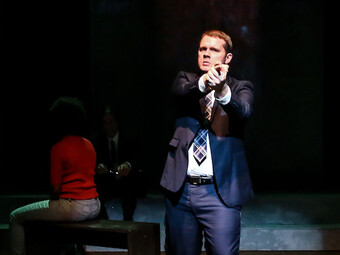Ethnodrama and Her Opponent
The Drama in the Data
Johnny Saldaña, author and Professor Emeritus of Theatre in the Herberger Institute of Design and the Arts' School of Film, Dance, and Theatre at Arizona State University (ASU), began his plenary speech on the second day of the NYU Steinhardt Program in Educational Theatre’s Forum on Ethnodrama by asking what role ethnodrama has to play in a “post-truth” world. He identified President Trump’s personal driver as “the art of fabrication,” a description frightfully similar to the definition of theatre. Yet while Trump’s lies are fabricated with the purpose of deceiving, theatre lies to the audience in order to tell the truth.
Ethnodrama is, roughly speaking, the dramatization of data. It is theatre that is made out of research, often conducted in the form of interviews but also including primary sources like journal entries, field notes, and media artifacts. Saldaña calls it “reality theatre,” the ultimate goal of which is understanding.
Ethnodrama is the dramatization of data.
In his speech, he urged ethnodramatists to blur genres and embrace aesthetics—to think theatrically even as they attempt to parse reality. The artistic offerings I saw in the course of merely the second day of the forum reflected the vast range of subgenres within ethnodrama. (In his seminal book on the subject, Ethnodrama: An Anthology of Reality Theatre Saldaña identifies more than eighty terms that can be applied.) I spoke with the chair of the forum, Joe Salvatore, clinical associate professor of educational theatre at New York University’s Steinhardt School, who said the performances along with papers and workshops digging into the what, how, and why of ethnodrama, ultimately raised a larger question for him: “What is ‘a play’?”
Salvatore’s own most recent ethnodrama, Her Opponent, just closed at the Jerry Orbach Theater at the Snapple Theater Center in New York. An early staging was presented at NYU in February, and for that event Salvatore embraced the term ethnodrama. Yet when moving Off-Broadway, he found that “documentary theatre” made more sense to theatregoers than the more academic term. Her Opponent is, regardless of what the press release says, ethnodrama. It restages excerpts of the 2016 presidential debates with gender-reversed casting in an attempt to understand how reception of the two major candidates was influenced by gender. Salvatore and his partner-in-creation, Maria Guadalupe of INSEAD, discovered that their experiment reveals as much about politics in general as it does about gender.
Guadalupe selected moments from all three debates and wove them into one thirty-five-minute play, then Salvatore worked with the actors using Anna Deavere Smith’s technique, in which the actor memorizes the exact inflections and exact gestures/movements of a real-life subject. Trump’s character is known as Brenda King, and Clinton’s as Jonathan Gordon. A twenty-five-minute post-show discussion follows the performance, in which Guadalupe and Salvatore have been continually amazed to find that even as a woman, the Trump character still comes out the favorite.
Audiences are finding King/Trump to be concise, authoritative, and commanding. Alternately, they find Gordon/Clinton’s incessant smiling to be totally off-putting. When King attacks, Gordon doesn’t fight back; she just nods and smiles. In the body of a man, this response is disconcerting at best and, at worst, at least one audience member found him “extremely punchable.”
At the performance of the off-Broadway production that I saw, audience responses largely repeated these same tropes: Gordon was received as too wonky and phony, while King was easier to understand and more emotionally appealing.
Emotions ran strong in everyone’s responses, with one audience member going so far as to call the performance a “horror show” that felt like a “slow-motion replay of a murder.” Guadalupe, who moderated the discussion, noted that these emotional responses might stem from the fact that this is a theatrical performance and not a real debate. In other words, there are no real world consequences for policy or governance for an audience watching Her Opponent, only the space and time to revisit the election with a little distance, with that distance being provided not only by the passage of time but also by the gender-flipped casting. As with Bertolt Brecht’s alienation effect, the emotions of Her Opponent’s audiences are not removed from the equation by this distance, but are, rather, heightened.
Audience members note that King, not being a man, is less threatening than Trump, which allows them to see Trump’s pacing less as stalking and more like a toddler on the verge of a tantrum. The fact that he simply exercised much more ownership of the space than she did also becomes more apparent when the threat is removed. Audiences also note Gordon’s tendency to use uptalk—a feminine tendency to use an upward inflection at the end of a sentence, a tactic we use in order to invite a response from our listener—when they had never noticed it in Clinton before. It was always there, but only once embodied in a man did it come into stark relief.
In fact, even though in real life, Clinton does not come across as all that stereotypically feminine, her behaviors are so inherently feminine that some audience members assume that the actor playing Gordon has been directed to act feminine or even to play gay. In reality he has not been directed that way; that impression arises purely from him exactly imitating Clinton.
All of these responses reveal that we are so programmed to see femininity as weak and masculinity as strong that even when masculine behaviors are embodied in a woman, she comes across as authoritative and confident. Feminine behaviors on the other hand, make even men read as subordinate and even a little laughable.
Whereas people who have met Clinton up close find her easy to connect to and personable, her debate performances and speeches are so heavily coached that she comes across a bit stale. Like most women, she likely has been told all of her life to smile more. Unfortunately, smiling and nodding in response to being attacked may be feminine, but it doesn’t make her any more likable than she would have been had she fought back. In fact, the audience response to King—a woman who speaks and behaves with all the bravado, aggression, and sweeping masculinity of Trump—may imply that women have far more freedom to behave that way than they think without being thought of as bitches.
Aside from the performance of gender, what becomes crushingly clear from this experiment is that even when the debate has real-world consequences in terms of policies and governing, voters are swayed as much by their emotions as by which candidate’s positions they agree with. In a fascinating twist, Salvatore told me that multiple female audience members have been shocked by their dislike of Gordon and their like of King and have realized as a result that perhaps they give women candidates a free pass because they want to have more elected women in government. Indeed, I heard this very comment the night I attended the performance.
One other audience response has fascinated Salvatore: On Show-Score the audience reviews have been largely positive, but even the people who liked it the most have said, “But…it’s not a play.”
What, then, is a play? Does everything have to be entirely made up for the show to be a play? Under that rubric, even Pulitzer Prize-winning Sweat by Lynn Nottage and the Broadway hit Indecent by Paula Vogel would not count as plays, as they are firmly based in research.
Just as the term ethnodrama includes at least eighty subgenres, the idea of “a play” needs to be thought of as broadly containing many types of performance. In today’s post-truth world, no doubt we need as many of them as we can collectively muster. In fact, I would argue that ethnodrama, as a kind of play, might be the perfect mode of theatre to meet the moment. If the excitement around Sweat and Indecent tells us anything, it’s that audiences are hungry for theatre that tells them the truth about our past and our present, and this is exactly what ethnodrama aims to do.
Ethnodrama insists, even in a post-modern world, that the truth is out there, and that a theatricalization of the systematic collection of data can reveal it.
If I had a theatre home right now, I would be doing as much ethnodrama as I could. I long to restage the speeches Trump gave early in his presidency where he planted staff as audience members and instructed them to applaud wildly—I want to see the difference between the performance with the planted audience and one without. I also want to make Living Newspapers, a form adapted from Russian practice by the Federal Theatre Project’s Hallie Flanagan, about the difference between health insurance and health savings accounts, or about the impact of Trump’s proposed higher tariffs on prices at Walmart. I am working on an adaptation of Strindberg’s A Dream Play in which Indra’s daughter visits an Appalachian coal mining country in order to understand the suffering of the disenfranchised, with the text being drawn from the many think-pieces written about Trump supporters in the wake of an election in which they voted against their own economic interests on supposedly economic grounds.
Ethnodrama, it seems to me, might be the perfect kind of fabrication to address Trump’s insistence that there is no such thing as truth. Ethnodrama insists, even in a post-modern world, that the truth is out there, and that a theatricalization of the systematic collection of data can reveal it.
So, HowlRound community, what contemporary topics would you make an ethnodrama? What data would you use as your text? Do you think that show would be “a play”? Let me know your thoughts in the comments section.








Comments
The article is just the start of the conversation—we want to know what you think about this subject, too! HowlRound is a space for knowledge-sharing, and we welcome spirited, thoughtful, and on-topic dialogue. Find our full comments policy here
I am working right now on a piece about the Tulsa Race Riot of 1921, looking at the accounts recorded by survivors and the way white newspapers reported the event. Taking these documents, I compare the 1921 stories to modern day Tulsans' stories which I am collecting through story circles.
I have two ethnodrama ideas in mind: one related to social media and one about weight.
Interesting! What would your source material be?
I'm still in the nebulous thoughts phase as I have two articles to write first. With social media, though, I was thinking of mining from posts and comments in some fashion.